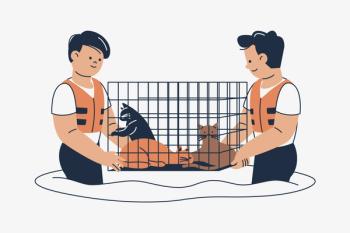
- dvm360 January 2024
- Volume 55
- Issue 1
- Pages: 18
Prioritizing a kitten’s emotional well-being during physical exams

Creating a comfortable, stress-free environment in the veterinary clinic can help reduce fear-induced misbehavior
Feline patients can often give veterinary professionals a tougher time getting through regularly scheduled appointments because of their behavioral habits. Despite continued advances in feline health care, behavior problems are still the most common cause of euthanasia in pet cats.1
However, to avoid any unwanted behaviors, preventive measures can be taken when cats are at a young age. Particularly with clinic appointments, veterinary professionals can create a safe and stress-free space for cats to feel more comfortable when visiting. This stress-free environment is especially important because, according to the American Association of Feline Practitioners, fear is the primary cause of misbehavior.2 At the Fetch dvm360 conference in Long Beach, California, behaviorist Christopher Pachel, DVM, DACVB, CABC, owner of Animal Behavior Clinic, Portland, Oregon, shared his best practices for handling routine feline examinations, specifically focusing on reducing fear in kittens.
During the session, Pachel prompted attendees to ask themselves whether their current protocols are “procedure centered,” with success defined by completion of the task and potentially without factoring in the pet’s emotional needs, or whether protocols are “patient centered,” with success focused on the patient’s emotional experience during appointments that are conducted with alternative protocols when fear, anxiety, and stress are present.3 “I worry that we’re missing the opportunity to really understand the animal’s emotional well-being, knowing that those kittens that we’re seeing at 6 weeks, 8 weeks, 10 weeks, 12 weeks, are forming their impressions of what veterinary care looks like.… These are the exams where a lot of those formative impressions are created,” he said.
To back up his points, Pachel shared a survey taken from more than 1000 cat guardians based on their pets’ behavior. The 28-item questionnaire found the following statistics4:
- 51.5% of guardians saw signs of stress prior to leaving home.
- 73% of cats were scared, annoyed, and/or aggressive in the waiting area of a veterinary clinic.
- 85% of cats showed signs of stress, escape behavior, and/or aggression during the examination.
- 58% of cats showed signs of stress after they returned home.
Michael Jaffe, DVM, MS, CCRP, DACVS, associate professor and service chief of small animal surgery at Mississippi State University College of Veterinary Medicine, also shared his thoughts on feline exams during an interview at the Fetch conference. “I always say that when we’re doing an exam on dogs, we pretty much are in control of when the exam is over,” he said. “But when we’re doing our exam on cats, it’s really the cat who is in charge of this situation, and they determine when the exam is over. So, we really need to be very efficient with what we’re doing, but also not do anything to scare or hurt the cat. Because once they’ve decided that your time is up doing your exam, your time is up. We can make use of sedatives to complete our exam or other methods, but we really try to do things as Fear Free as we possibly can to give us more of a chance to do a complete exam on these cats.”
Constant awareness of the patient’s well-being
Body language
Pachel stated that recognition of the patient’s comfort level starts with staying aware of body language throughout interactions and procedures. “Are we looking at the pupils? Are we looking at that widened eye? Where are the ears? Are they pointed forward more neutrally? Are they starting to rotate more caudally?” Pachel asked. Jokingly, he added, “There are several reasons why those ears may rotate backwards. From a veterinary perspective, they’re all bad,” causing attendees to laugh in agreement.
Back to a more serious note, Pachel continued, “Are we seeing cats who are hiding? If we give them the ability to move throughout the room, do they tuck underneath the chair and never come back out again? That’s an emotional barometer, a way to read where that cat is at in that moment. When we see them moving, are they walking comfortably and upright with that tail up in the air, strutting their way through with that nice little wiggle in the waist and that tail bouncing?” These are all signs Pachel recommended to look out for when the kitten is in the exam room.
Positive reinforcements
Besides reading body language, Pachel also recommended having positive reinforcements handy in the room. These can include toys like feathers, laser pointers, and plush toys, and treats with multiple flavor and texture options. “We’ve got to have a lot of options there for them to be able to pick and choose. And maybe the more [options] we have available, the more efficient it is to see which ones naturally elicit that response from the kitten,” Pachel stated. These reinforcements can also be used as a distraction if needed to complete a task like collecting a blood sample.
Physical touch during examination
When handling the kitten, Pachel recommended avoiding firm restraint if possible. Instead, he suggested using slow movements and moving with the kitten in the direction they are already going in while freely exploring the countertops or tables. Using soft hands and less tension on the body can also help. “It’s more of a guidance rather than a restricted movement. And we’re allowing the animal a degree of control,” Pachel said.
If a firm restraint is necessary, try not to hold that position for more than a few seconds. However, in general, Pachel emphasized the need to avoid scruffing except during emergency situations. Instead, team members should learn to provide adequate restraint through gentle body manipulation or proactive use of towels.
Keeping the future in mind
Overall, Pachel stressed the importance of creating and maintaining these behavior protocols with kitten exams in order to improve future appointments with the patient. “Ideally as we deliver care over the next 20-plus years, hopefully, for this kitten, we’re going to do this many, many times. And if each experience further sensitizes to the animal that this is a negative experience, it’s full of stress, then that creates a cumulative learning process that requires, again, more and more [anxiety-reducing drugs like] gabapentin as we go forward,” Pachel reminded attendees.
If the patient is comfortable visiting the clinic at a young age with emotionally positive experiences, they are more likely to maintain a level of comfort moving forward. He also mentioned that these strategies can evolve and mold to fit certain patients and practices once you find what works best.
REFERENCES
- New JC Jr, Salman MD, King M, Scarlett JM, Kass PH, Hutchinson JM. Characteristics of shelter-relinquished animals and their owners compared with animals and their owners in U.S. pet-owning households. J Appl Anim Welf Sci. 2000;3(3):179-201. doi:10.1207/S15327604JAWS0303_1
- Feline behavior guidelines. American Association of Feline Practitioners. December 2004. Accessed December 21, 2023.
https://catvets.com/public/PDFs/PracticeGuidelines/FelineBehaviorGLS.pdf - Pachel C. Incorporating behavior into your kitten exams. Presented at: Fetch dvm360 conference; December 1-3, 2023; Long Beach, CA.
- Mariti C, Bowen JE, Campa S, Grebe G, Sighieri C, Gazzano A. Guardians’ perceptions of cats’ welfare and behavior regarding visiting veterinary clinics. J Appl Anim Welf Sci. 2016;19(4):375-384. doi:10.1080/10888705.2016.1173548
Articles in this issue
almost 2 years ago
Under the skinalmost 2 years ago
What pet owners really wantalmost 2 years ago
Assessing the risk of avian influenzaalmost 2 years ago
Stress reduction in animalsalmost 2 years ago
Conference forecast for 2024almost 2 years ago
The strain of senior petsalmost 2 years ago
The new year: Out with the old?almost 2 years ago
Revealing pain points in catsNewsletter
From exam room tips to practice management insights, get trusted veterinary news delivered straight to your inbox—subscribe to dvm360.






